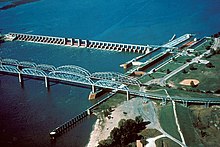| Lock and Dam No. 26 | |
|---|---|
 Old Lock and Dam 26 and the Old Clark Bridge with a swing span rail bridge in between. | |
| Country | USA |
| Location | Alton, Illinois |
| Coordinates | 38°53′10″N90°10′55″W / 38.88611°N 90.18194°W |
| Purpose | River navigation and channel depth maintenance |
| Status | Decommissioned |
| Construction began | 1939 |
| Demolition date | 1990 |
| Built by | Engineering Construction Corporation,-- composed of Spencer, White and Prentis, George A. Fuller Company, and Turner Construction Company, all of New York City |
| Dam and spillways | |
| Type of dam | Three steel roller gates and thirty Tainter gates, all of the submergible type, with concrete sills and separating piers |
| Impounds | Upper Mississippi River |
| Length | 1724 feet moveable section |
| Reservoir | |
| Maximum length | 38.5 miles |
| Lock 26 | |
|---|---|
 | |
| 38°53′10″N90°10′55″W / 38.88611°N 90.18194°W | |
| Waterway | Mississippi River |
| First built | 1938 |
| Length | 600 feet (180 m) main, 360 feet (110 m) auxiliary lock |
| Width | 110 feet (34 m) main, 110 feet (34 m) auxiliary |
| Fall | 25 feet (7.6 m) |
| Above sea level | 419 feet MSL of upper pool |
Lock and Dam No. 26 was a lock and dam located near Alton, Illinois on the Upper Mississippi River around river mile 202.5.
Contents
Opened in 1938, its largest lock was 600 feet long. It was demolished in 1990 and replaced by the Melvin Price Locks and Dam, which is also known as Lock and Dam number 26.